
“We are not the only ones who know that the moon can be reached. We are not the only ones planning to go there. The race is on—and we had better win it!”
Director: Irving Pichel
Starring: John Archer, Warner Anderson, Tom Powers, Dick Wesson, Ted Warde, Erin O’Brien-Moore
Screenplay: Alford “Rip” Van Ronkel, James O’Hanlon and Robert A, Heinlein, based upon the works of Robert A. Heinlein
Synopsis: Scientist Charles Cargraves (Warner Anderson) and General Tom Thayer (Tom Powers) watch in horror as their experimental rocketship, intended to put a satellite into orbit around the Earth, crashes and burns. Cargraves speaks grimly of sabotage… Two years later, Thayer approaches aeronautics expert Jim Barnes (John Archer) about his and Cargraves’ new project: a rocket to the moon. Barnes scoffs until he hears that Cargraves has designed an atomic engine, and successfully tested a scale model. Barnes gathers his fellow industrialists together, demonstrating a model of the proposed rocket, and explaining to them how space flight is indeed feasible. Thayer then tries to convince the men of the military imperative of the mission: that other nations are also planning a moon flight, and that whichever country is first able to locate missiles on the moon will control the Earth… With money and resources at their disposal, Cargraves, Thayer and Barnes have their rocket, the Luna, built. As the project nears completion, however, obstacles begin to arise: protests against the launch occur, and the men are denied permission to test their atomic engine. Barnes insists that this opposition has been orchestrated, and makes a startling proposition: that they take off without testing the engine, at the next favourable time—which is only seventeen hours away. Cargraves and Thayer agree, but their plans are thrown into chaos when their radioman, Brown (Ted Warde), is hospitalised with appendicitis. Desperate, the men try to convince Brown’s assistant, Joe Sweeney (Dick Wesson), to go along; he agrees only because he does not believe the rocket will work. At the last moment, a court order arrives forbidding the men to take off, but they board their ship before it can be served. The launch is successful, and to the joy of Cargraves, Thayer and Barnes – and the horror of Sweeney – they are soon travelling through space. Despite difficulties such as weightlessness and space-sickness, the journey goes as planned until it is discovered that Sweeney mistakenly greased the ship’s aerial: it has frozen in place. Barnes, Cargraves and the chastened Sweeney don their pressure-suits and go outside the ship to fix the problem. As Barnes and Sweeney work on the aerial, Cargraves goes to check the engines. Finding that his safety line is not long enough, Cargraves unties it. Kneeling to inspect the engines, he does not realise that his magnetic boots have lost contact with the ship. The next moment, Cargraves is drifting in space…
Comments: Of all the science fiction films of the 1950s that are today acknowledged as “classics”, Destination Moon is the least known and most under-appreciated, probably because it offers comparatively little to the casual viewer. Ironically enough, it is the very qualities that make this film so important that doom it as entertainment: its technical accuracy; its deliberately low-key, almost documentary approach; and above all its deadly earnestness – there are no cheap thrills here. Sadly, this means that although Destination Moon is a landmark in the development of the science fiction film, and a pioneering work in the true sense of the word, it can really only be correctly estimated by the viewer who approaches it with some knowledge of its historical importance, and an active sense of good will. You will find no aliens, no monsters, no ray-guns, no strange women in leotards – and no “love interest” – in Destination Moon; just a painstakingly factual account of how mankind might go about building a rocket that would take him to the moon.
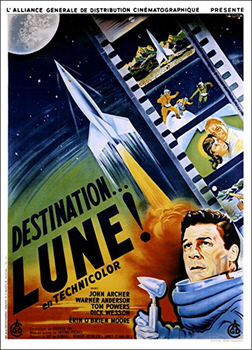
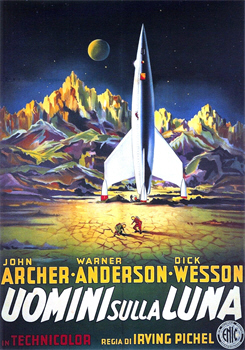

Despite this (or perhaps because of it: this was, after all, an era when the expression “Popular Science” was not an oxymoron!), at the time of its first release the film was enormously successful, grossing about ten times its outlay. Those of us who have lived through a time when space shuttle flights were so commonplace as to barely rate a mention on the news unless something went wrong might find it hard to understand what the fuss was all about. To appreciate, indeed, to enjoy Destination Moon as it deserves, we must put ourselves in the place of the audiences of the 1950s, as they were first confronted with a concept so radical, so outrageous, as a rocket to the moon—and then told that it could really happen. The film is listed in NASA’s official timeline of the history of space travel, and rightly so.
Destination Moon was made at a time when humanity stood on the brink of an amazing step forward, and by people who were among the first to grasp that such a thing was possible. While the onscreen action is, unfortunately but undeniably, rather stodgy, the production as a whole is nevertheless infused with a sense of wonder, of optimism, of simple faith in man and what he could achieve. Destination Moon is remarkable – and, looked at from the correct perspective, thrilling – for being the only space flight film made in the heyday of the science fiction film to be truly about space flight. This is not a story about being on the moon, but of getting there; the adventure is all in the doing.
Destination Moon was the brainchild of writer Robert A. Heinlein and producer George Pal, the latter of whom managed to sell a studio on the idea of making a serious film about travelling to the moon after the concept was initially dismissed as “too fantastic”.
(Film studios weren’t the only ones who thought so: in 1948, The American Journal Of Physics published a paper in which the authors explained exactly why a human being could never travel to the moon. Their chief error was assuming that the 4:1 fuel:rocket launch mass ratio of the V-2 rocket could not be bettered.)
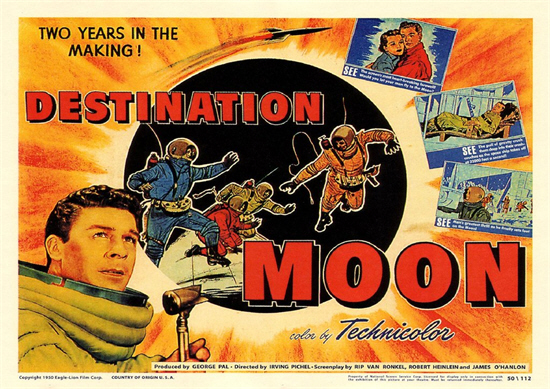
From the start, the project was undertaken with the utmost seriousness. Specialist consultants were brought in to ensure its authenticity, most notably Hermann Orbeth, an expert on rockets who had previously worked with Fritz Lang on 1929’s Die Frau Im Mond (the only other “realistic” space flight film made to that time), and Chesley Bonestell, the astronomical artist whose glorious paintings and illustrations did so much to bring “outer space” into the collective American consciousness during the late forties and early fifties. Together with Pal and Heinlein, these men managed to instill into their other collaborators their own belief in the realities of space flight, and to have Destination Moon produced under a policy of accuracy above all. The results of this mindset are evident throughout the film, which not only illustrates what was known at the time of its production, but is also startlingly prescient about the things that would happen when man finally ventured into space.
When the film opens, Charles Cargraves and Tom Thayer are intent, not upon the moon, but merely upon putting a satellite into orbit. The failure of the enterprise is a crushing blow to both men – to Thayer in particular, who has destroyed his career, “campaigned himself right out of the service”, in pursuit of the conquest of space – but they show themselves to be made of the right stuff, squaring their shoulders and going back to the drawing-board.
And when, two years later, Thayer visits aeronautical entrepreneur Jim Barnes (who he addresses fondly as “Jimmy”), he is no longer intent merely upon launching a satellite, but upon being the first to reach the moon itself. Barnes is understandably sceptical, but is swayed by the news of Cargraves’ “atomic engine”, and still more by Thayer’s argument that the mission is one of national defence; that whoever reaches the moon first will be able to build missile bases there.
This call to his patriotism, combined with his love of scientific pioneering, is enough to convince Jim Barnes, who succeeds in recruiting his fellow industrialists to the cause, arguing that they, and only they, have the resources that the program requires, and that they can get the job done in the time it would take the government to finishing debating the point. The money-men are intrigued but hesitant; and again, it takes Thayer’s exhortations about missile bases on the moon – “There is absolutely no way to stop an attack from outer space!” – to seal the deal. It is the oldest of the industrialists, who has lived through two world wars, who first rises to meet the challenge, and his younger brethren are swift to follow his lead.

Although it erred in putting the construction of the rocket into the hands of private industry – a distinctly Heinleinian notion – one of most interesting things about Destination Moon is its anticipation of the fact that the main impetus for the space race would ultimately be military, not merely scientific.
While the film-makers’ commitment to accuracy was laudable, it presented them with a substantial difficulty: how to communicate in a comprehensible fashion the concepts on which their story was based, to an audience that (it was assumed) possessed little if any knowledge of them—without turning their entertainment into a lecture on astrophysics. To their credit, the writers avoided one common pitfall: they do not have Cargraves, Barnes and Thayer telling each other things that they most assuredly already know, in order to convey that information to the audience.
However, in avoiding one trap, the writers unfortunately fell into another, one that makes Destination Moon extremely difficult for a modern audience to swallow: scared of talking above their audience, they talked down to it instead. The first manifestation of this comes while Barnes and Thayer are pitching their case to the industrialists. Barnes himself, being in aeronautics, has a grasp of the theories of rockets and space travel; his peers, understandably, do not.
This sets up the most unexpected part of Destination Moon: a “training film” starring none other than—Woody Woodpecker! The recalcitrant bird – and the audience, of course – is given a swift lesson in the practicalities of rockets and moon landings; and by the end of it, Woody himself is thoroughly convinced; although the industrialists – who, somewhat unbelievably, chuckle good-naturedly all the way through the cartoon – do require more flag-waving from Thayer before they commit to the project.
(In what is clearly a step taken to spike the critics’ guns, Woody initially dismisses the notion of a rocket to the moon as “comic-book stuff”. “LIFE Magazine doesn’t think so!” retorts the narrator, showing him an issue that just happens to carry a cover story on—the production of Destination Moon! [April 1950, for those interested.])


Now, all of this is amusing, in a kitschy sort of way; but what happens next is not. Having successfully launched their pioneers in their rocket, the makers of Destination Moon then felt the need to explain all the mysteries of space travel itself—and it is here that the film not only becomes difficult to take in its own right, but bestows upon the science fiction films that followed it, apparently in perpetuity, a terrible legacy: the Odious Comic Relief©.
Enter Joe Sweeney, who reluctantly becomes part of the crew when his senior is struck down by appendicitis on the very eve of the mission. Joe, to the surprise of no-one who has suffered torments courtesy of his monstrous progeny over the ensuing decades, is a blue-collar working joe – geddit? – perpetually wisecracking, and hailing from, yes, Brooklyn.
(He doesn’t like space because, as he so eloquently puts it, there’s, “No beer, no babes, no baseball!” Yeah, yeah: how about them Dodgers, Joe?)
Joe’s layperson status means that he is ignorant of all aspects of space flight, and therefore must – conveniently enough – have everything explained to him. Unfortunately, Pal & Co. thoroughly overreached themselves here: so eager were they to ensure that the audience missed nothing, that Joe’s ignorance proves to be of a truly startling magnitude. At one point, he must even be reminded that, “There’s no air in outer space!” “There’s room for it!” he replies, unconvinced.
It is impossible now to gauge how people reacted to Joe Sweeney in 1950; whether they appreciated his presence, or whether they found his character a piece of unforgivable condescension, as viewers today are certain to do. In any case, it is difficult to believe that anyone ever found Joe other than unbearably irritating and unfunny—although whether this would have been the case had an actor other than Dick Wesson been chosen for the part, it’s hard to say. I’ve never seen Wesson in any other film, so I don’t know whether his role here reflected his actual persona, or whether he was “acting”. Let’s hope the latter. Either way, he is astonishingly annoying; heck, even his teeth are annoying! The supreme irony of Destination Moon, of course, is that while its painstaking accuracy had no influence whatsoever upon the film-makers that copied it, its single biggest mistake – viz., Joe Sweeney – would be unfailingly reproduced in almost every science fiction film made during the years that followed.


But in the end, we have to forgive the makers of Destination Moon both Joe and Woody, in simple recognition of how much they managed to get right—and to predict.
The model rocket that Barnes demonstrates to the industrialists is more than three-quarters “reaction mass”; today’s rockets are over 90% fuel. The Woody Woodpecker cartoon explains concepts such as overcoming gravity, travel in a vacuum, reverse thrust, and parachute-assisted landings; while the crew must deal with problems including the effects of G-force (real, but overestimated), weightlessness (overcome by magnetic boots), space-sickness, and the difficulty of swallowing in zero gravity.
Whole scenes in this film envision what would happen when mankind did ultimately travel into space. The rocket crew marvels at its view of the Earth, anticipating the staggering images that would be broadcast for the first time in 1968 by Apollo 8. (The views of the Earth shown are also an accurate representation of what anyone travelling in a ship following the same flight path as the Luna really would see.) A problem with the ship’s aerial forces Barnes, Cargraves and Sweeney to don their pressure-suits and do an EVA, a feat that both the Soviets and the Americans would achieve in 1965. There is a problem as the Luna is about to land on the moon, and Barnes must make an abrupt readjustment; the Apollo 11 crew would experience a similar difficulty. And once on the moon, Barnes and Cargraves are contacted by radio from the Earth—although due to the particular framework of the movie, it is the media that contacts them, not the government.
Most memorable of all, however, is the moment when the moon is first “claimed”. Thayer insists that it is for Barnes and Cargraves to first step out onto the moon, while Barnes in turn graciously concedes the ultimate honour to Cargraves. The acting in Destination Moon is rarely better than competent, but it reaches its pinnacle here, as Warner Anderson’s Cargraves must speak around a distinct lump in his throat in order, “By the grace of God, and in the name of the United States of America”, to claim the moon, “For the benefit of all mankind”. (Excluding, we assume, that portion of mankind at whom American missiles would soon be aimed.) The plaque that today rests upon the moon’s surface reads, “Here men from planet Earth first set foot upon the Moon, July 1969 A.D. We came in peace for all mankind”. You can only wonder how far life imitated art.
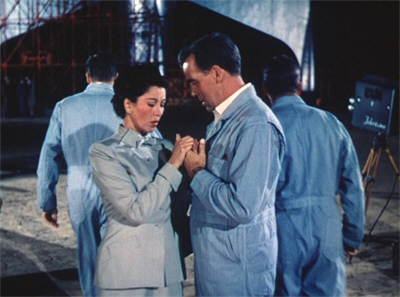
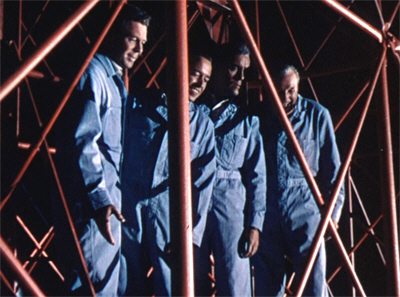
Of course, it is only natural that Destination Moon wouldn’t get everything right, and there are a few flubs here and there. The Luna is a single stage rocket, and a far cry in its design from the three-stage system that would finally get the job done. (Another instance of “copy the mistake”: almost every space film for the following decade or so would reproduce the sleek, silvery lines of the Luna for its own rocket.) It also lands on the moon itself, rather than the ship orbiting, and the crew descending to the moon’s surface in a landing module, as would ultimately be the case.
These errors are excusable. More problematic is the simplicity, not to say naivety, with which space travel itself is undertaken. When forces on Earth begin to move against the Luna project, attempting to prevent lift-off, Jim Barnes comes up with a startling idea: rather than wait a month, as planned, they will exploit the next possible launch window—which is only seventeen hours away. “But we haven’t had time to train a crew!” objects Cargraves. “Then we’ll go ourselves,” counters Barnes, and they do, just like that—dragging the wholly uninformed and unprepared Sweeney along with them.
And despite all the expert input, there are a few design flaws in Destination Moon. The worst of them is the painfully unconvincing “star fields” with which the Luna is surrounded at all times. These were actually realised using car headlights—and unfortunately, look like it. The “stars”, almost identical in colour and intensity, and closer together than real stars ever were, are a major distraction throughout the otherwise well-executed EVA sequence. Another mistake, a more surprising one, is Chesley Bonestell’s design for the surface of the moon, which looks like a huge dried lake-bed, all dramatic cracks and geometric patterns. Bonestell himself afterwards lamented his error, claiming, not that he could have known what the moon looked like, of course, but that he could have deduced it. Be this as it may, Bonestell’s paintings are one of the true highlights of Destination Moon, and even if his moonscapes are wrong, they’re such a pleasure to look at that we have no trouble overlooking the fact.
(Oh, and by the way: I’m perfectly well aware that after my strictures against Outland for ignoring facts in order to “look cool”, this sails perilously close to hypocrisy. If Outland had gotten as much right as Destination Moon, I would have cut it a little slack, too.)


By now you might be asking, with all this “science stuff” in Destination Moon, is there any story? Well, yes, some—but not all that much, and what there is, is at all times subservient to the film-makers’ commitment to the practical and the possible.
The machinations of the rocket project’s enemies on Earth allow for a race against the clock to complete the building of the Luna, and then another race to take off before a threatened court order can be invoked. Once the crew is in space, it is discovered that Sweeney mistakenly greased the ship’s aerial (time for a lecture, Joe!), which has naturally frozen in place, and must be cleaned before it will extend. This leads to the EVA, and to the first of the film’s two suspense sequences.
As Barnes and Sweeney are dealing with the aerial, Cargraves moves down the rocket to inspect the engines—and, when he finds it is not long enough, he slips his safety line.
(In dramatic terms, that Cargraves would do such a thing is easily the least believable part of the story, particularly seeing that it was he who delivered the safety lecture!)
Engrossed in his work, Cargraves does not notice that his magnetic boots have lost contact with the surface of the rocket. The next instant he is floating in space, and it takes some very quick thinking on the part of Barnes to resolve the situation.
The other dramatic set-piece comes at the climax of the film, when it is discovered that Barnes’ emergency manoeuvring during landing used up too much fuel. Even when everything that can be unloaded from the ship has been, it is still too heavy—meaning that one of the crew must stay behind if the others are to make it back to Earth…
Problems involving a lack of necessary fuel became a popular plot point in many of the films that followed Destination Moon. Here, while the method of calculation is accurate, the notion that rocket fuel is – or can be – calculated down to the single pound is less so.
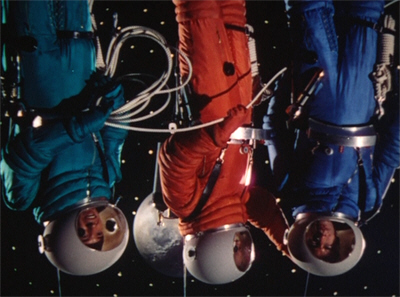

What is interesting about these two sequences is the degree of tension that director Irving Pichel manages to generate, given that we know in our hearts that nothing bad is going to happen to anyone. Other films may have been willing to dispose of their space explorers – or at best, to allow them to sacrifice themselves – but Destination Moon isn’t like that: it’s far too optimistic a work, too certain of man’s ability to rise to any challenge. And yet suspense is created. While we know that everything will turn out all right, we don’t know how: that is where the interest lies. In its details, as well as in its conception, Destination Moon is an intellectually enjoyable movie.
Science fiction films may claim to be, intend to be, about “the future”, but they very often say a great deal more about the time in which they were produced; and Destination Moon is no exception. The film is not only a fascinating snapshot of the political climate of America in 1950, but is often so in wholly unexpected ways. For one thing, the screenplay is amazingly critical of the government—so much so, that had the film been made by people of rather more leftish leanings, it is likely that they would have found themselves summoned for a chat with Senator McCarthy and his colleagues. But there is, of course, a profound philosophical difference between criticising a government for being too hawkish, and criticising it for not being hawkish enough; and it is the latter of which Destination Moon is guilty.
“Good grief, man! – and the government hasn’t taken that over!?” exclaims Barnes incredulously, upon hearing from Thayer about the success of Cargraves’ scale-model atomic engine. The opening section of the film repeatedly bemoans Washington’s “peacetime” attitude, berating the government for cutting appropriations, for not seeing the military necessity of continuing the rocket program.
Furthermore, the screenplay implies, there is a specific reason for this attitude…one that Tailgunner Joe himself would have heartily applauded. Destination Moon is a Cold War film par excellence, and never more so than in its claim that both the government and the media are deeply infiltrated by enemy agents working to undermine the American Way Of Life in general, and the rocket program in particular.

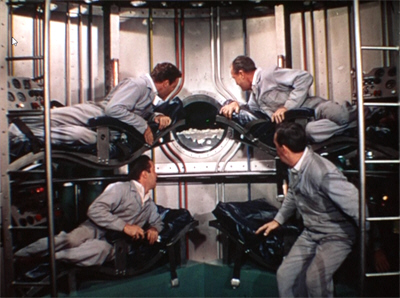
Some of the assumptions that are made in Destination Moon, and the way in which they are made, are nothing short of staggering. For instance, in the opening scene, Cargraves’ first rocket has barely lifted off before it crashes back to earth. Not for a moment does it occur to Cargraves that something could have been wrong in his design or execution; this must be sabotage, he claims, and Thayer instantly agrees. Later we are told that the Secret Service “knows” that this was the case, although we do not know how, nor hear of any action taken as a consequence.
Having recruited industry to their cause, Barnes, Cargraves and Thayer get their rocket built, but learn that taking off will be another matter. Along with its overt argument that private industry is better able to handle a project like the building of the Luna than is government (“The vast amount of brains, talent, special skills, the research facilities necessary for this project aren’t in the government: they’re here!” Barnes insists to his fellow industrialists), there is a covert suggestion that it is also better equipped at guarding against infiltration and sabotage. Unable to get at the Luna as “they” did to Cargraves’ rocket, “they” therefore resort to a smear campaign instead, which may be conducted from a safe distance.
Cargraves shows the others a newspaper headlined by a story about mass protests against the launch. “That’s not public opinion!” says Thayer angrily. “It’s a job of propaganda!” “Manufactured and organised!” agrees Barnes. “Somebody’s out to get us!” At no time do they give any indication of why they think this; it is so, it must be so, and that’s all there is to it. Similarly, when Cargraves must report that their request to test their atomic engine has been denied, Barnes is furious, seeing it as one more orchestrated barrier—the inference being, apparently, that no-one could really be concerned about something as trivial as the dispersal of radioactive material.
(Given that the time of Destination Moon’s production was also that during which the U.S. government commenced its program of secret experiments, in which uninformed individuals, both military and civilian, were deliberately exposed to radiation, these scenes are rather chilling. Nor does “the Commission”’s suggestion that the crew shift the atomic engine test to “the South Pacific” make things any better, given the radiation exposure suffered both by the indigenous population and by U.S. servicemen during the atomic testing in the Marshall Islands.)


It is then that Barnes comes up with his radical suggestion that they lift off as soon as possible. “There’s no law against taking off in a spaceship, because no-one’s ever done it!” he points out, further arguing that if the three of them ask permission, “they” will find another way of stopping them. Sure enough, at the last minute a court order is served, forbidding the take-off—and implying that “they” have infiltrated the court system, as well. The crew-members respond as any good Americans would: by evading the order and making a dash for their rocket, laughing and jeering at the server from the safety of the elevator.
(I’ve long been fascinated by the ability of Americans to hail their country as the greatest in the world because of its laws and institutions, while simultaneously thumbing their noses at those very laws and institutions, apparently without any sense of contradiction.)
More accurately, it is Barnes, Thayer and Sweeney who laugh and jeer at the warrant server: Cargraves has other things on his mind. One interesting touch in Destination Moon, although it is by no means emphasised, is the inference that for the military man Thayer and the industrialist Barnes, their careers are everything; it is Cargraves alone, the scientist, who has managed to combine his work with a home and a family.
(The film’s pursuit of contemporary realism precludes any women from being involved in the rocket flight itself, but we should note that there are women working in Jim Barnes’ design section.)
In this, too, Destination Moon displays an interesting reversal in its assumptions from the bulk of its copyists, in granting its scientist a perfectly normal life. Indeed, after the disaster that opens the film, Cargraves announces to Thayer his intention of taking a proper break before returning to the problem of the rockets, and spending some quality time at home, during which he will “get reacquainted” with his wife and his children, and, “Mow lawns, fix leaky faucets, paint fences, and read detective stories in the bathtub.” We get no such sense of a life outside of work for either of Cargraves’ colleagues.

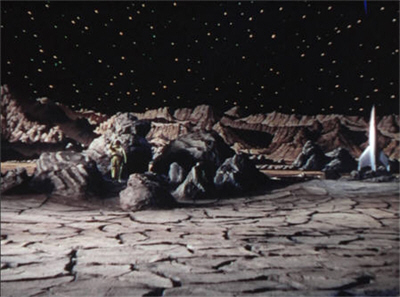
However, it is easy enough to infer that although no actual criticism of Cargraves is intended here, the writers of this film believed that this was a time in history that those most concerned with shaping America’s destiny – those high up in the military and the industrial complex, that is, not the scientists, and certainly not those in government – could not afford the luxury of relaxation. What is most intriguing about the political content of Destination Moon is that the “they” referred to so frequently are never identified: the word “Communist” is never uttered at any point in the film. Then again, in 1950, it was scarcely necessary to utter it.
(The closest we ever get is Barnes complaining about “red tape”, and I’m not even sure that was intended euphemistically, although the context is suggestive.)
It is also remarkable, given the overall tenor of the film, that the technological abilities of this unnamed enemy are freely conceded: “they” are not just planning on going to the moon, but capable of getting there; this, a full seven years before the launch of Sputnik shook the United States out of its sense of complacency, and kicked off the space race in earnest.
Destination Moon is unique in the annals of the science fiction film for the clarity and conviction of its vision, and for its refusal to take a single step outside the boundaries of what its makers believed to be the truth. Even 2001: A Space Odyssey, that other great “space travel” film, is not so pure. Indeed, the only films that come close to Destination Moon in this respect are two other George Pal productions: Conquest Of Space, which is in every way an inferior creation, and When Worlds Collide…perhaps. (Ah, but what’s that on the horizon in the final scene…?)
In one sense, Destination Moon was hugely influential – space films flourished for over a decade, until reality began to supersede fantasy – and in another, not influential at all. While other film-makers were quick to jump on the bandwagon, they had little if any interest in imitating their model’s integrity. Even the very first copycat film, Rocketship X-M, had its astronauts encountering a group of Martians.

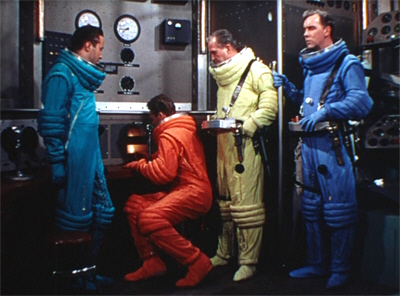
(Inspired by the media coverage of Destination Moon’s production, the makers of this knock-off managed to get their film written, shot and into the cinemas a month before Destination Moon was released!)
It is not difficult to see why this would have been the case. Destination Moon’s authenticity really left other film-makers with nowhere to go—except into the realm of exploitation.
In fact, you can just imagine the kind of conversation that potential copyists – just for laughs, let’s call them “Roger”, “Jim” and “Sam” – might have held upon viewing the film:
Roger: “That’s a pretty good film. I could make it cheaper, though—and it wouldn’t take me two years! Hmm…needs something to spice it up. A better title, for a start—”
Jim: “One that’d look good on a poster. Attack Of The—something-or-other. And we need something to get the kids in. Aliens, or monsters—”
Sam: “Sexy dames, and plenty of ’em!”
And indeed, this is exactly how the space film would evolve – or degenerate – over the following years. Destination Moon, meanwhile, continued to be the sole occupant of the tiny niche it had created for itself, until events in the real world made it redundant.
Looking at the film today, it is far easier to see this film’s faults than its virtues. The acting is low-key to the point of invisibility (Dick Wesson’s excepted; if only he were invisible!), and the script so determinedly matter-of-fact that it sails perilously close to being outright dull. Plus, there’s no sex, and no violence; no aliens, and no monsters; just pure science, of a kind that today we all take for granted.
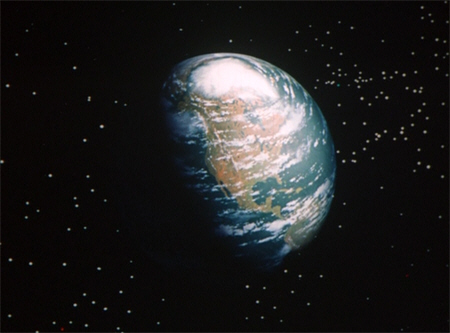
The 1950s were truly the golden era of the science fiction film, and the importance of Destination Moon in that context cannot be overestimated. If these days it is a struggle to appreciate the film as it deserves to be appreciated, that in itself is a strange kind of compliment. Perhaps the very highest praise offered to Destination Moon comes from those who dismiss it as too real to be entertaining. This is a film that, on a certain day in 1969, effectively ceased to be science fiction at all. And how its makers must have gloried in that!
Want a second opinion of Destination Moon? Visit 1000 Misspent Hours – And Counting…and, sigh, The Bad Movie Report.
And there’s just a leetle bit more in Spinning Newspaper Injures Printer…

There must have been a LOT of THEM to obstruct the progress that much.
Why, don’t you know that America is great because it is America. It’s a tautology, and anyone who dares to point out anything that might not be perfect is simply told to “Love it or Leave it!” It’s only the laws we agree with that are right. All others are due to “overreaching government”. I could go on and on, but it gets too depressing.
There have been studies done on the advances made by the space industry, that have benefited many other fields (Tang, for example). The benefits actually far outweigh the costs. Most of the advances were accidental in nature, and research without a definite end is frowned upon by cost analysis.
LikeLike
“You may have all these marvellous rights, which make America the greatest country in the world…but if you exercise any of them, you’re a dirty liberal socialist Commie!”
“Ours laws and institutions are the foundation of our greatness…and so fragile that all opposing views must be silenced, as they will crumble at a touch.”
As you say, sigh…
Oh, yes, nearly all the best advances are accidental. Since we’re quoting Asimov— “The most exciting phrase to hear in science, the one that heralds new discoveries, is not ‘Eureka!’ but ‘That’s funny’…”
LikeLike
But never “hold my beer and watch this..”
LikeLike
There are significant elements of Heinlein’s Rocketship Galileo here, particularly the illicit launch – but of course that book also had a Nazi moonbase, probably the first one in fiction. Some bits of his The Man Who Sold the Moon show up too, too, and that hadn’t yet been published.
LikeLike
“Another mistake, a more surprising one, is Chesley Bonestell’s design for the surface of the moon, which looks like a huge dried lake-bed, all dramatic cracks and geometric patterns. Bonestell himself afterwards lamented his error, claiming, not that he could have known what the moon looked like, of course, but that he could have deduced it.” Chesley did lament getting the mountains on the Moon wrong, with the extremely craggy peaks he had painted, but he was NOT responsible for the surface cracks seen in Destination Moon; they were not his doing.
LikeLike
Welcome, Melvin. Thank you for the clarification. 🙂
LikeLike
You’re welcome. The set designer(s) made the cracks as a way to try and make the lunar set seem bigger than it was. The crack patterns were actually smaller and smaller in the distance. They also had smaller people in smaller spacesuits in the distance, to try and make it seem they were regular sized but much farther away!
LikeLike
Wish I had seen this article while I was writing mine.
See Centauri Dreams June 12th 2020. (Cant seem to past the link.)
This is the 2nd time I have seen Herman Obreth’s name as a technical adviser on Destination Moon. Obreth had nothing to do with the film, tho in an indirect way Fritz Lang did.
Robert Heinlein was the technical adviser , tho he did consult some his scientific friends in California.
Heinlein probably was 90% the reason this movie got made, Pal was the enabler.
LikeLike
Thank you! – I was actually reading your piece yesterday. 🙂
Thank you too for the correction on Herman Obreth: there are certainly numerous sources that insist he was involved. Perhaps it was the coincidence of his arrival in America (which I dealt with re: Woman In The Moon) with the pre-production of Destination Moon? Maybe they wanted him as a consultant and couldn’t get him; or maybe they just announced his involvement for publicity purposes?
LikeLike
I don’t know , there is a review somewhere else, can’t remember where, that also mention’s Obreth as technical adviser, Obreth was in Europe after the war tho did come , at von Braun’s invitation, in the late 1950s and was around of and on in the US.
Odd thing is Willy Ley, who could have been a technical adviser on Destination Moon was upset when Heinlein wrote him in New York and wanted to be paid if he answered Heinlein’s questions.Ley later praised the movie.
It is odd that Lange , who made Frau im Mond in 1929 would be kind of the root of Destination Moon. As I mentioned Lang and Heinlein ,by way of Ley’s introduction, talked about a film and even briefly huddled over it, tho Lang could not find a studio interested in doing it, so gave up..
i looked but could find no reference to what Lang thought of Destination Moon.
LikeLike
Ah, no, you’re right: it was the late 40s when the US was first in contact with Obreth, but the mid-50s before he arrived in the country.
There are plenty of sources that have him involved with DM but there must have been an initial misapprehension that was widely propagated.
I didn’t come across any references to Lang in this context either. It’s strange to think about all of these connections, though! 🙂
LikeLike